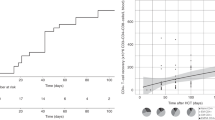Abstract
Cytokine-mobilized peripheral blood progenitor cells (PBPCs) have been used successfully for hematopoietic reconstitution following allogeneic transplantation. The ease of harvest, the faster engraftment and the high yield of CD34+ cells have made this source of hematopoietic progenitor cells (HPCs) an attractive alternative to bone marrow (BM). In the present study we compared the engraftment potential of conventional BM allografts and single leukapheresis products (LPs) collected from healthy donors following the administration of granulocyte colony-stimulating factor (G-CSF). For this, lineage-committed and primitive HPCs were assessed by flow cytometry and by colony- and cobblestone area-forming cell (CFC, CAFC) assays. Mean numbers of CD34+ cells in LPs (n = 11) were similar to that of BM grafts (n = 12) (278 ± 57 vs 227 ± 34 × 106 CD34+ cells). The frequencies of CFCs, week 5 CAFCs and week 8 CAFCs were 1.6-, 8.4- and 10.3-fold higher in the CD34+ compartment of mobilized blood than that of marrow, resulting in significantly higher yields of clonogenic HPCs in LPs when compared to BM grafts. We conclude that G-CSF preferentially mobilizes clonogenic progenitors capable of short- and, in particular, long-term reconstitution, and that the engraftment potential of single LPs is superior to that of BM allografts. Hence, the use of PBPCs may be favorable for protocols that include graft manipulations with expected cell loss (eg T cell depletion, CD34+ selection). PBPCs may also be advantageous for gene therapy trials due to their high numbers of potential target cells (eg CAFCs).
This is a preview of subscription content, access via your institution
Access options
Subscribe to this journal
Receive 12 print issues and online access
$259.00 per year
only $21.58 per issue
Buy this article
- Purchase on Springer Link
- Instant access to full article PDF
Prices may be subject to local taxes which are calculated during checkout
Similar content being viewed by others
Author information
Authors and Affiliations
Rights and permissions
About this article
Cite this article
Theilgaard-Mönch, K., Raaschou-Jensen, K., Andersen, H. et al. Single leukapheresis products collected from healthy donors after the administration of granulocyte colony-stimulating factor contain ten-fold higher numbers of long-term reconstituting hematopoietic progenitor cells than conventional bone marrow allografts. Bone Marrow Transplant 23, 243–249 (1999). https://doi.org/10.1038/sj.bmt.1701579
Received:
Accepted:
Published:
Issue Date:
DOI: https://doi.org/10.1038/sj.bmt.1701579
Keywords
This article is cited by
-
Pluripotent and myeloid-committed CD34+ subsets in hematopoietic stem cell allografts
Bone Marrow Transplantation (2003)
-
Flow cytometric assessment of lymphocyte subsets, lymphoid progenitors, and hematopoietic stem cells in allogeneic stem cell grafts
Bone Marrow Transplantation (2001)



